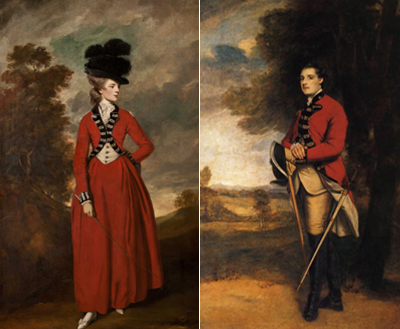Sir Richard Worse-Than-Sly Exposing His Wife's Bottom. . .
This is the first of two prints with the same title and the same publication date of March 14th, 1782. This one, published by H. Brown, Oxford Market, seems to have been released only as a plain, uncolored print. And in the examples I have seen, the ink is light and the line thin, resulting in a kind of washed-out quality. The other, with the basic image reversed, a much stronger line, and several important additional changes, was published by William Humphrey in both plain and colored versions.

© National Portrait Gallery, London
Both prints and a third one published about six weeks later, A Peep into Lady W!!!!!y's Seraglio, were responses to a notorious criminal conversation (crim con) trial held on February 21st, 1782 involving Sir Richard Worsley, Lady Seymour Worsley, and Lady Worsley's lover, Captain George Bissett.
At the age of 17, the wealthy and attractive Seymour Fleming had married Sir Richard Worsley, Baronet, after a brief but suitable courtship. A rising politician and would-be collector of art and antiquities, Sir Richard, for his part, seems to have married Fleming solely to acquire a suitable trophy wife, a possession designed to enhance both his finances and his status. Indeed he seems to have preferred to show off his wife to friends and associates (even inviting them to share in his wife's favors) rather than perform the duties of a husband himself. Not surprisingly, after five years of such perverse behavior, Lady Worsley ran off with Captain George Bissett, one of the lovers who had been effectively solicited by Sir Richard.

Sir Richard and Lady Worsley [1776]
© Harewood House Trust
In the 18th century women were largely regarded as the property of their husbands. A proven adultery, consequently, was considered to diminish that property's value and allow the injured husband to sue for "damages." Sir Richard expected an open and shut case and sought £20,000 as recompense, an enormous and intentionally ruinous sum for Bissett who was a mere Captain in the South Hampshire Militia. The Baronet could not have been more wrong.
In a highly unusual and unexpected move, Lady Worsley's defense chose not to dispute the charge of adultery with Bissett, but to prove by the testimony of former lovers and other observers that Sir Richard had been fully complicit in his wife's affairs and hence had no cause to seek damages. A key piece of evidence was provided by Mary Marriott, an employee at the Maidstone Bath near Coxheath who testified about one late summer's day when Lady Worsley came to the bath accompanied by Sir Richard and Captain Bissett. The two men remained outside the bathhouse door. Over the door, however, was a window providing the only light into the enclosed area where Lady Worsley bathed.
[W]hen she had almost finished dressing herself, Sir Richard tapped at the door, and said,"'Seymour! Seymour! Bissett is going to get up to look at you. . . and looking round, [the bath maid] saw [Bissett's] face at the window. . .[He] coninued there about five minutes. . .[S]he did not see the Plaintiff [Sir Richard] on the outside, but believes he must [have helped] the Defendant up. [A]fter Lady Worsley had dressed herself, she went out, and they were all merry and laughing together.
Gillray's print nicely captures the reckless abandon of the participants as described at the trial. Lady Worsley is shown in a pose reminiscent of the Venus de Medici stepping down into the sunken bath, but looking slyly up at Bissett at the window, fully aware of what she is revealing and concealing. Standing upon Sir Richard's back, Bissett calls out a joking appreciation of the prospect before him: "Charming View of the Back Settlements, Sir Richard." And Sir Richard, in his turn, squatting as if he were sitting on a privy, describes his willing assistance in his wife's prostitution using a quotation from Matthew 11:30—My Yoke is Easy & my Burden Light." The working-class maid, holding the lady's clothes is no less abandoned from a moral perspective, but sees the situation as a lost economic opportunity: "Good lack! my Lady the Captn will see all for Nothing."
There is perhaps one further dimension to the print. For in this version, Sir Richard is looking out at the viewer with satisfaction, having successfully displayed his wife to yet another willing gaze.
Sources and Reading
- Commentary from the British Museum on Sir Richard Worse-Than-Sly Exposing His Wife's Bottom
- The Trial...between The Right. Hon. Sir Richard Worsley...and George Maurice Bisset...
- Hallie Rubenhold, The Lady in Red, 2008
- "Seymour Fleming," Wikipedia
- "Sir Richard Worsley, 7th Baronet," Wikipedia
Comments & Corrections
NOTE: Comments and/or corrections are always appreciated. To make that easier, I have included a form below that you can use. I promise never to share any of the info provided without your express permission.